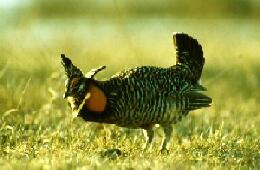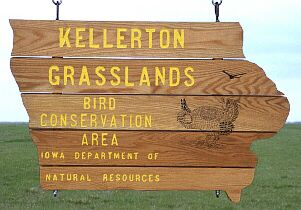|


The Reintroduction of Prairie Chickens to Iowa
by Mel Moe, Iowa DNR Wildlife Biologist, Mount Ayr, Iowa
Photos by Roger Hill and Mel Moe
Source: iowadnr.com/wildlife.files/FMAmay2000.html
 The group of bird watchers shivered in the chill of dawn in early April. Braving the chill air was worth it, however. On a ridge top, a few hundred yards east of the observation deck were 14 male prairie chickens competing for the affections of four hens who were also visiting this booming ground. Booming grounds are communal display areas where male prairie chickens are found each spring during March, April, and May. The vocalizations that male prairie chickens make while displaying is called booming. These sounds the male birds make by releasing air from special brightly colored air sacks on their necks. For nearly 50 years, the booming of male prairie chickens has been absent in Iowa. Today, however, the sounds of prairie chickens once again reverberate across their original Iowa range thanks to many generous individuals and work of the Iowa Department of Natural Resources Wildlife Bureau.
The group of bird watchers shivered in the chill of dawn in early April. Braving the chill air was worth it, however. On a ridge top, a few hundred yards east of the observation deck were 14 male prairie chickens competing for the affections of four hens who were also visiting this booming ground. Booming grounds are communal display areas where male prairie chickens are found each spring during March, April, and May. The vocalizations that male prairie chickens make while displaying is called booming. These sounds the male birds make by releasing air from special brightly colored air sacks on their necks. For nearly 50 years, the booming of male prairie chickens has been absent in Iowa. Today, however, the sounds of prairie chickens once again reverberate across their original Iowa range thanks to many generous individuals and work of the Iowa Department of Natural Resources Wildlife Bureau.
At the time of European settlement in the mid-nineteenth century and until about 1900, prairie chickens commonly nested throughout the state of Iowa. Their preferred habitat is an open, treeless expanse of grassland, something found across the state at that time, but now quite scarce in Iowa.
During the late nineteenth century, prairie chickens were the most abundant gamebird on the Iowa prairies and hunting and trapping them was very important to settlers, both for food and market. As agricultural land use intensified, populations of prairie chickens started to decline. By the 1950ís the only known nesting prairie chickens were in Appanoose, Wayne, and Ringgold Counties in southern Iowa. The last verified nesting prior to later reintroduction attempts was in Appanoose County in 1952.
In the early 1980ís the Iowa Conservation Commission, now the Iowa Department of Natural Resources (DNR), made an unsuccessful attempt to restore prairie chickens in the loess hills of western Iowa. A second reintroduction program was initiated by the IA DNR in 1987. This time the release site was on the Ringgold Wildlife Area located two miles north of the Missouri border in Ringgold County in south central Iowa. The DNR considered the region around this site to be the best potential prairie chicken habitat in Iowa. Recent years had brought some positive changes in the grasslands of the Area, and it was hoped that these changes would provide suitable habitat for prairie chickens once again. A major change was restoration, through management, of around 500 acres of prairie on the Ringgold Wildlife Area. Other changes were better pasture management by some area farmers, and the Conservation Reserve Program of the United States Department of Agriculture which converted thousands of acres of cropland into a diversity of mostly undisturbed grasslands for at least 10 years.
The birds for this reintroduction were obtained from Kansas. Crews from Iowa trapped the prairie chickens on booming grounds in the spring and immediately hauled the birds to Iowa where they were released. A total of 254 prairie chickens were moved to the Ringgold Wildlife Area from Kansas during the years 1987, 1988, and 1989. Another 295 birds were captured in Kansas and stocked in Ringgold and Adair Counties in 1991, 1992, and 1993.
The program has proven successful. This spring there are several prairie chicken booming grounds in Ringgold and Decatur Counties as well as in nearby areas of Missouri and there have been numerous sightings in Wayne County.
 To insure that at least minimal habitat for prairie chickens and other grassland birds exists in the future, the DNR and Partners in Flight initiated the Kellerton Bird Conservation Area. The goal of this project is to have a core area of 2000 acres of publicly owned and managed grasslands within a 10,000 acre block that contains at least another 2000 acres of privately held grassland habitat. To date the DNR has acquired 680 acres with the financial support provided by REAP grants and monies donated by various conservation groups and individuals. The Kellerton Bird Conservation Area is being actively managed to provide optimal habitat for the area's prairie chickens though activities such as tree removal, prairie restoration, burning, and grazing. To insure that at least minimal habitat for prairie chickens and other grassland birds exists in the future, the DNR and Partners in Flight initiated the Kellerton Bird Conservation Area. The goal of this project is to have a core area of 2000 acres of publicly owned and managed grasslands within a 10,000 acre block that contains at least another 2000 acres of privately held grassland habitat. To date the DNR has acquired 680 acres with the financial support provided by REAP grants and monies donated by various conservation groups and individuals. The Kellerton Bird Conservation Area is being actively managed to provide optimal habitat for the area's prairie chickens though activities such as tree removal, prairie restoration, burning, and grazing.
The Kellerton Bird Conservation area is home to the largest known booming ground in Iowa, and the DNR and WOODLINK, LTD, a manufacturer of quality birdhouses and birdfeeders, have constructed a raised viewing platform from which Iowans can observe the annual spring displays of prairie chickens. Viewing is best within an hour of sunrise or sunset during the months of March and April, with some activity on the booming ground until the end of May. On nice mornings, males can also be seen on the site from mid October through February. The viewing platform is open to visitors at all times, and is handicapped accessible. Visitors are asked to respect the no trespassing signs which have been posted to avoid disturbance of the booming ground from February through mid-May.
NOTE: Many early pioneers and settlers hunted prairie chickens and avoided starvation when food resources were running low.- SRB
Transcription by Sharon R. Becker, 2007
HISTORY INDEX
|
